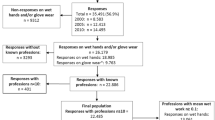Abstract
Background objectives: Nursing is known for its high prevalence of hand dermatitis, mainly caused by the intense exposure to wet work in nursing activities. We aimed to study the characteristics of wet work exposure in nursing. Method: Trained observers monitored the duration and frequency of different wet work activities in 45 randomly chosen nurses from different wards during a morning shift, using a method of continuous observation based on labour-observation techniques. Results: Wet work in intensive care units accounted for 24% of the overall morning shift duration, with a frequency of 49 incidents. This was 16% in dialysis wards, with a frequency of 30 incidents, and 9% on regular wards, with a frequency of 39 incidents. The wet work activities had short mean duration cycles. The mean duration of occlusion by gloves was 3.1 min on regular wards and 6.7 min in intensive care units. Discussion: The characteristics of wet work in nurses differed substantially, depending on the ward. According to the German regulation TRGS 531, our observations classify nursing as a wet work occupation, due to the frequency of wet work rather than its duration. The mean duration of occlusion in our observations was short, which makes an occlusion-induced irritating effect doubtful. Reduction in wet work exposure in nursing on regular wards could focus on the reduction of the frequency of hand-washing and patient-washing. We suggest increasing the use of gloves for patient washing. Although this will increase exposure to occlusion from gloves, it may reduce the frequency of exposure to water and soap by about a quarter.



Similar content being viewed by others
References
Barnes RM (1980) Motion and time study, design and measurement of work, 7th edn. Wiley, New York
Dickel H, Kuss O, Blesius CR, Schmidt A, Diepgen TL (2001) Occupational skin diseases in Northern Bavaria between 1990 and 1999: a population-based study. Br J Dermatol 145:453–462
Dickel H, Kuss O, Schmidt A, Kretz J, Diepgen TL (2002) Importance of irritant contact dermatitis in occupational skin disease. Am J Clin Dermatol 3:283–289
Held E, Wolff C, Gyntelberg F, Agner T (2001) Prevention of work-related skin problems in student auxiliary nurses: an intervention study. Contact Dermatitis 44:297–303
Hendrix ATM (1997) Instruction for performing time studies (Nota P 97–94). IMAG Institute, Wageningen, The Netherlands
Hendrix ATM, Looije AAJ, Van der Schilden M (2000) Waarnemings-en vastlegtechnieken in de arbeidskunde. IMAG, Wageningen
Jungbauer FH, Lensen GJ, Groothoff JW, Coenraads PJ (2004) Handeczeem in de zorgsector [Hand dermatitis in the healthcare sector]. Tijdschrift voor Bedrijfs-en Verzekeringsgeneeskunde 12:135–139
Jungbauer FH, Lensen GJ, Groothoff JW, Coenraads PJ (2004) Exposure of the hands to wet work in nurses. Contact Dermatitis 50:225–229
Lammintausta K (1983) Hand dermatitis in different hospital workers who perform wet work. Derm Beruf Umwelt 31:14–19
Lammintausta K, Kalimo K (1981) Atopy and hand dermatitis in hospital wet work. Contact Dermatitis 7:301–308
Lammintausta K, Kalimo K, Aantaa S (1982) Course of hand dermatitis in hospital workers. Contact Dermatitis 8:327–332
Lammintausta K, Kalimo K, Havu VK (1982) Contact allergy in atopics who perform wet work in hospital. Derm Beruf Umwelt 30:184–188
Lammintausta K, Kalimo K, Havu V (1982) Occurrence of contact allergy and hand eczemas in hospital wet work. Contact Dermatitis 8:84–90
Lammintausta K, Maibach HI, Wilson D (1987) Human cutaneous irritation: induced hyporeactivity. Contact Dermatitis 17:193–198
Larson E, Friedman C, Cohran J, Treston-Aurand J, Green S (1997) Prevalence and correlates of skin damage on the hands of nurses. Heart Lung 26:404–412
Malten KE (1981) Thoughts on irritant contact dermatitis. Contact Dermatitis 7:238–247
Malten KE, den Arend JA (1985) Irritant contact dermatitis. Traumiterative and cumulative impairment by cosmetics, climate, and other daily loads. Derm Beruf Umwelt 33:125–132
McCracken S (1999) Latex glove hypersensitivity and irritation: a literature review. Probe 33:13–15
Nettis E, Colanardi MC, Soccio AL, Ferrannini A (2002) Occupational irritant and allergic contact dermatitis among healthcare workers. Contact Dermatitis 46:101–107
Nilsson E (1986) Individual and environmental risk factors for hand eczema in hospital workers. Acta Derm Venereol Suppl (Stockh) 128:1–63
Pal TM, Spreewers D, Laan van der G, Stinis HPJ, Brand T, Kuijer PFM et al (2003) Alert report on occupational diseases. Coronel Instituur, Netherlands Center for Occupational Diseases, Universiteit van Amsterdam
Ramsing DW, Agner T (1996) Effect of glove occlusion on human skin (II). Long-term experimental exposure. Contact Dermatitis 34:258–262
Ramsing DW, Agner T (1996) Effect of glove occlusion on human skin. (I). Short-term experimental exposure. Contact Dermatitis 34:1–5
Schnuch A, Uter W, Geier J, Frosch PJ, Rustemeyer T (1998) Contact allergies in healthcare workers. Results from the IVDK. Acta Derm Venereol 78:358–363
Smit HA, Burdorf A, Coenraads PJ (1993) Prevalence of hand dermatitis in different occupations. Int J Epidemiol 22:288–293
Wrangsjo K, Meding B (1997) Occupational dermatitis—what’s new? Hospital workers. Clin Dermatol 15:573–578
Author information
Authors and Affiliations
Corresponding author
Rights and permissions
About this article
Cite this article
Jungbauer, F.H.W., Steenstra, F.B., Groothoff, J.W. et al. Characteristics of wet work in nurses. Int Arch Occup Environ Health 78, 248–251 (2005). https://doi.org/10.1007/s00420-004-0561-y
Received:
Accepted:
Published:
Issue Date:
DOI: https://doi.org/10.1007/s00420-004-0561-y




